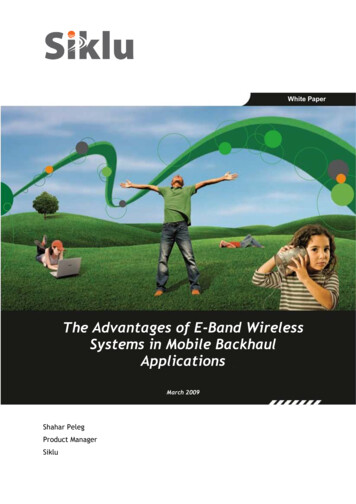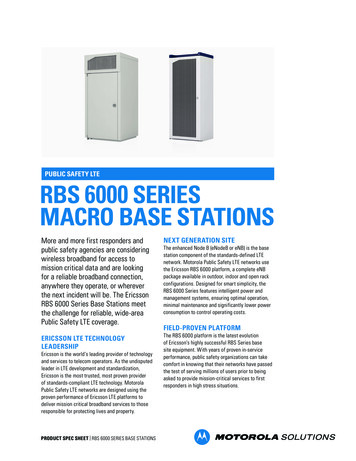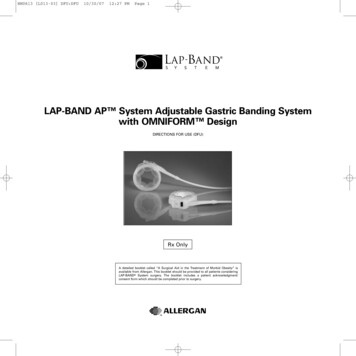
Transcription
White PaperThe Advantages of EE-BandBand WirelessSystems in Mobile BackhaulApplicationsMarch 2009Shahar PelegProduct ManagerSiklu
Table of ContentsExecutive Summary . 3The Mobile Backhaul Challenge . 4The Solution: Ethernet/IP-Based Backhaul . 5Mobile Backhaul Alternatives . 7Using E-Band for Ethernet Wireless Systems . 9Propagation Characteristics of the E-Band Spectrum . 11Conclusion . 14About Siklu. 14 Siklu Inc. 20092
Executive SummaryTo meet growing subscriber demand, mobile operators are constantly seekingadditional network capacity to enable the delivery of bandwidth-intensive dataservices. Nowhere are these challenges felt more acutely than in the backhaulnetwork. Understanding the advantages, operators are migrating to all-Ethernet/IPbackhaul networks. However, “traditional” packet-based backhaul transportsuffers from a number of inherent limitations. In places where there is fibercoverage, fiber can provide the required capacity and more. However, fiber reachis often limited, and deploying new fiber links is often prohibitively expensive.Copper has limited capacity and reach, and “traditional” microwave links sufferfrom spectrum congestion and limited channel size.Today, as the demand for bandwidth increases daily, operators who rely onwireless backhaul are turning to new frequency spectrums to lower their wirelessbackhaul costs. Wireless systems operating in the newly-allocated E-Band spectrum(71-76 GHz, 81-86 GHz and 92-95 GHz) - also referred to as millimeter-wavewireless systems - have clear technological and economic advantages. As such, theE-Band spectrum is expected to become the “Next Generation Wireless BackhaulSpectrum” playing an important role in easing the backhaul pain of mobileoperators. Siklu Inc. 20093
The Mobile Backhaul ChallengeThe introduction of broadband cellular technologies such as HSPA, LTE and WiMAX- which provide users with DSL-likelike and higher data speeds at flat-rateflatpricingmodels - is changing consumer mobile phone usage habitshabits,, making mobile webbrowsing and emailingmailing routine. This changchanging user behavior generatesgenerathugeamounts of data, leading to an explosion in bandwidth demands as data trafficdoubles and even triples. This data explosion places an ever-increasingincreasing strain onoperators’ mobile backhaul networks.The mobile backhaul network is commonly referred to as the transport links,links whichconnect cell sites (Base Stations, Node B, eNodeB) with the core switching andmanagement elements (ass can be seen in Figure 1). Traffic, both voice and data,data istransported to and from the cell sites via the backhaul network,network delivering therequireded services with high reliability and availability.Figure 1 – a snapshot of the mobile backhaul networkIn today’s cellular networksnetworks, the backhaul network is mostly comprised of coppercopperbased E1/T1 circuits, and “traditional” TDMTDM-based 6-3838 GHz microwave links.Deterministic transport technologies, such as PDH and SDHSDH, do not scale efficientlyand thus do not provide a costcost-efficientefficient solution for the dramatic increase inbackhaul capacity demands. If mobile operators continue using “traditional” TDMTDMbased backhaul technologies, service quality for both voice and data applications Siklu Inc. 20094
will at some point suffer - as the incremental addition of more TDM-basedbandwidth is economically unjustifiable.Increasing the capacity by adding more E1/T1 or TDM links is certainly technicallyfeasible. However, it is extremely costly, inefficient and often too time-consumingto meet immediate bandwidth needs. Operators are seeking new and differentsolutions - based on a more scalable, flexible and economically suitable technology- to upgrade their backhaul network. The technology chosen must be able todeliver a substantial change in the economics of scale, as backhaul capacitydemand will grow to hundreds of Megabits-per-second, and even Gigabits-persecond.It is commonly accepted by the worldwide mobile operator community that CarrierEthernet technology holds the technological answers to reducing mobile backhaulnetwork Total Cost of Ownership (TCO), while still providing the necessarybandwidth to meet current and future demands. By introducing lower-costEthernet links into the backhaul network, operators are enjoying lower OpEx andCapEx.The Solution: Ethernet/IP-Based BackhaulThe key to coping with the bandwidth explosion in the mobile backhaul network isadoption of a more scalable, flexible and cost-efficient backhaul technology.Ethernet/IP has emerged as the leading technology for metro networks in general,and wholesale services in particular. In the backhaul, Ethernet allows operators toquickly scale bandwidth on a pay-as-you-use basis, reaching Gigabit-per-secondcapacities without major infrastructure changes.Understanding this, mobile operators worldwide have started to migrate to allpacket-based networks - starting by implementing Ethernet/IP/MPLS technologiesin their core networks. However, to get the most out of packet technology, mobileoperators must also introduce this technology in the backhaul segment. Siklu Inc. 20095
Mobile operators have three main strategic options to evolve backhaul networksnetwork toan all packet-basedbased infrastructure, as depicted in Figure 2:TDM1. “Traditional” - Continue using “traditional”, E1/T1 and TDM-basedbackhaul infrastructure, make efforts to optimoptimizeize the network andintroduce packet-basedbased infrastructure in the futurefuture, when they feelconfident with the technology.2. tutilizes“traditional”, TDM-basedbased backhaul for voice traffictraffic, while offloading datadattraffic to a separate packet backhaul networknetwork, which will eventually carryall combined traffic.3. “All-Packet” – Implement and utilize an all packet backhaul infrastructuredirectly, enjoying the capacity and cost advantages that Ethernettechnology has too offer immediately.Figure 2 – evolving to an all-Ethernet/IP networkEvolving to an all Ethernet/IP backhaul network also has its challenges:1. Carrier grade capabilities – as the leading technology in carrier networks,Ethernet needs to provide mobile operators with carrier grade capabilitiesthat meet the rigorous support and management demands of multipleservice types, Quality of Service (QoS)(QoS), service prioritization,prioritization reliability, andadvanced Operation, Administration & Operation (OAM) and managementcapabilities. Siklu Inc. 20096
2. Supporting existing legacy services - TDM services and packet services areexpected to continue coexisting in the same network for quite some time.Using Pseudowire Emulation Edge to Edge (PWE3) and other encapsulatingtechnologies, TDM-based legacy voice services can be reliably transportedusing the Ethernet/IP backhaul network.3. Providing synchronization over the packet-based network - Mobilenetworks are highly dependent on clock and timing information transfer tosynchronize. With the introduction of packet-based backhaul, newsynchronization technologies such as IEEE 1588v2 and Synchronous Ethernethave come into play, providing clock and timing information.Mobile Backhaul AlternativesNot long ago, when mobile services involved mostly voice, backhaul bandwidthrequired for cell sites was just a few Mbps. Copper-based E1/T1 and PDH/SDHmicrowave backhaul links were sufficient for transporting these services. However,with the introduction of 3G mobile networks, and as mobile broadband dataservices became more popular, these links are no longer able to scale up andprovide the necessary bandwidth at reasonable costs. Operators are thus migratingto Ethernet-based transport solutions - whether xDSL over copper, Ethernet andHybrid microwave or fiber optic.As backhaul capacity requirements are expected to continue growing, particularlywith the introduction of 4G mobile networks, mobile operators are left with fewrelevant options for the backhaul network (as depicted in Figure 3):1. Copper – VDSL/VDSL2 may be able to provide the necessary bandwidth.However, it offers limited reach (tens of meters) and therefore may not berelevant.2. Fiber optic – fiber can provide all the necessary backhaul bandwidth bothtoday and in the future. However, fiber is not always readily available, andnew fiber links are often prohibitively expensive to deploy - costing from 2,500 to 10,000 per meter, due to the high costs of excavation, trenchingand rights of way. Siklu Inc. 20097
3. Ethernet/IP Wireless systems – can provide backhaul links to cell sites thatare either out of reach of fiber deployments, and in cases where new fiberdeployments are not cost effective.E-Band wireless systemsE-Band wireless systemsE-Band wireless systemsFiber optic cableFiber optic cable6-38 GHz TDM wirelesssystems6-38 GHz single channelEthernet wireless systems6-38 GHz multi-channelEthernet wireless systemsCopperCopper10 Mbps2G100 Mbps1000 Mbps3G4GFigure 3 – transport options to provide cell site backhaul capacityToday’s wireless backhaul is comprised of PDH/SDH links operating in the“traditional” 6-38 GHz frequency spectrum. Understanding the advantages ofEthernet/IP transport technologies, mobile operators are introducing Ethernet/IPbased wireless links which also operate in the “traditional” 6-38 GHz frequencyspectrum. Due to this extremely high demand, the 6-38 GHz frequency spectrum isbecoming increasingly congested, particularly in dense urban areas where theincreased backhaul capacity is particularly important. Furthermore, the maximumallocated channel bandwidth in this frequency spectrum does not exceed 56 MHz,and even with high-order modulation schemes such as 256 QAM, the maximum linkcapacity of such systems does not exceed 350-500 Mbps. As operators requiregreater capacity, these systems will need to utilize multiple radios - leading tohigher equipment costs, higher frequency licensing costs, and even morecongestion of the spectrum.Operators worldwide are looking for new wireless solutions that are scalable andflexible in providing necessary bandwidth, while also allowing them to reducewireless backhaul expenditures. The newly allocated E-Band spectrum (71-76 GHz,81-86 GHz and 92-95 GHz) has the potential to become the “next rtechnologicalandeconomicadvantages over the lower 6-38 GHz spectrum. Siklu Inc. 20098
Using E-Band for Ethernet Wireless SystemsThe newly-allocated E-Band spectrum (71-76 GHz, 81-86 GHz and 92-95 GHz) hasbeen designated for ultra-high capacity point-to-point communications (fixedlinks). The US FCC was first to regulate and allocate the E-Band spectrum in 2003,followed in early 2007 by Ofcom in the UK. Regulators worldwide are soon tofollow the FCC and Ofcom’s lead, allocating this spectrum in a consistent mannerworldwide. In Europe, CEPT has published a formal recommendation for theallocation of the E-Band spectrum, and ETSI is expected to approve itsrecommendation for wireless systems operating in this band by the end of 2009. Ingeneral, local and national regulators both within and outside of the EuropeanCommunity follow the recommendations and guidelines provided by CEPT and ETSI.The new E-Band frequency spectrum has clear technological and economicaladvantages over the lower 6-38 GHz spectrum. Millimetric-wave wireless systemsutilize a dramatically larger allocated spectrum divided into significantly largerchannels to deliver multi-gigabit data rates. By comparison, the largest allocatedchannel in the 6-38 GHz spectrum is 56 MHz while the smallest typical channel sizein the E-Band is 250 MHz - which can scale up to 5 GHz (as seen in Figure 4). Byutilizing the large allocated spectrum and channels, E-Band wireless systems canbe considerably more robust, while simultaneously easing modem and radiorequirements. Thus, millimetric-wave wireless systems provide significant costadvantages over the lower “traditional” wireless systems, allowing scaling up togigabit-per-second capacities, without additional radio equipment or licensingfees.56 MHz maximumchannel size0 GHz5 GHzchannelsize5 GHzchannelsize10 GHz 20 GHz 30 GHz 40 GHz 50 GHz 60 GHz 70 GHz 80 GHz 90 GHz 100 GHzFigure 4 – channel size comparison between 38 GHz and E-Band Siklu Inc. 20099
Despite being affected by rain attenuation, the robust system design and higherantenna gains allows E-Band wireless systems to provide the necessary highcapacities with 99.999% carrier grade service availability at link distances of up tothree kilometers. Considering that ultra-high backhaul capacities are generallyrequired in urban scenarios where distances between the mobile base stations arerelatively short (1.5 Km average for urban and 2.5 Km for suburban scenarios), EBand wireless systems are ideal in these locations. Needless to say, these urbanand sub-urban scenarios account for 80% - 90% of the network elements requiring abackhaul solution.Yet another economic advantage of the E-Band frequencies over the “traditional”frequencies is the dramatic reduction of the licensing fee. The nature ofpropagation in the E-Band and the possibility of employing directional “pencilbeam” signal characteristics mean that applications can be implemented withminimal interference concerns - allowing potentially highly efficient spectrum reuse, reducing coordination requirements, and allowing regulators to adopt a “lightlicensing” scheme.In the UK, for example, the licensing fees for E-Band frequency licenses arenegligible - costing 50 for an annual license per link. While in the USA thefrequency license is even lower, with a 10-year license costing 75 per link. Thelicenses are obtained using an online registration process, lowering licenseacquisition time to just a few hours. In contrast, a frequency license in the 6-38GHz spectrum can cost up to several thousands of dollars annually, and can takeover a month to acquire. For operators with hundreds or even thousands of links intheir networks, these frequency licensing costs are a real concern.6-38 GHz wireless systemsE-Band wireless systemsLimited, highly congested (in urbanDramatically largeareas)Widely availableChannelsUp to 56 MHz250 MHz up to 5 GHzCapacitiesSub-gigabitGigabit and upFrequency licensingHigh-cost, time consuming“Light Licensing”Available spectrumLow-cost and immediateTable 1 – the advantages of E-band vs. 6-38 GHz wireless systems Siklu Inc. 200910
Propagation Characteristics of the E-Band SpectrumDespite being just recently allocated, the propagation characteristics, such as theweather behavior characteristics, of the E-band spectrum are well-known ewirelesssystemperformance is also affected by environmental conditions, including atmosphericattenuation and rain attenuation. The total transmission loss for a wireless link isgiven by: !" # # Equation 1 – the total transmission loss of a wireless link1. Atmospheric attenuation: Between 70 GHz and 100 GHz there is arelatively low atmospheric attenuation window, making these frequenciesattractive for high-capacity wireless transmission. At the 71-76 GHz and 8186 GHz spectrum the atmospheric attenuation is negligible - approximately0.5 dB/km. At around 60 GHz, there is major increase in the atmosphericattenuation caused by the oxygen absorption, limiting radio transmissiondistances for 60 GHz wireless systems.Figure 5 – atmospheric attenuation influencing the E-Band spectrum Siklu Inc. 200911
2. Rain attenuation: Rain affects microwave and millimetric-wave wirelesssystems. Rain attenuation has a significant influence on determining thepractical limits on wireless transmission distances, including systemsoperating in E-Band frequencies. For example, tropical rain falling at a rateof 100 mm/hour can cause attenuations of 30 dB/km to wireless systemsoperating in the E-Band spectrum. However, since severe weather eventsusually move quickly across the link, rain effects tend to be short-lived,especially over short links.Figure 6 – rain attenuation influencing the E-Band spectrum3. Fog/mist attenuation: Fog attenuation is relatively low in the E-Bandfrequencies and does not require consideration.As a native Ethernet systems, E-Band wireless systems can implement adaptivemodulation and coding (also known as adaptive rate) to significantly improveavailability and performance. Adaptive rate technology automatically makes thenecessary modulation and coding adjustments to the wireless system, optimizingover-the-air transmission and preventing weather-related losses from causingtraffic link disruption.When extreme weather conditions affect traffic over a wireless system, adaptiverate technology automatically lowers the modulation and coding schemes to Siklu Inc. 200912
improve the system’s link budget. By doing so, all-important real-time applicationscontinue to pass through uninterrupted, at the expense of lower priority, non realtime services. When the link conditions improve, the system automaticallyrecovers, returning to the original modulation and coding, higher throughputs, andbetter spectral efficiencies (as depicted in Figure 7).Voice andReal-timeservicesNon-realtimeservices64 QAM32 QAM16 QAM8 PSKQPSK8 PSK16 QAM32 QAM64 QAMTimeFigure 7 – improving link availability using adaptive rate technologyThe large allocated spectrum and channel sizes, together with high antenna gainsand adaptive rate technologies, enables effective compensation for atmosphericand rain attenuation. As such, E-Band millimetric-wave wireless systems canprovide carrier grade, gigabit-per-second capacities at 99.999% availability overdistances of up to three kilometers in most common rain zones worldwide. Siklu Inc. 200913
ConclusionAs subscriber demand for bandwidth increases exponentially, and data servicesprofit margins continue to shrink, the cost and complexity of increasing mobilebackhaul capacity and the quest to lower cost per bit is leading providers to seeknew backhaul alternatives. These concerns will grow even more serious asproviders plan their transition to 4G - LTE and WiMAX technologies and theiradvanced, flat-IP network architectures.Ethernet/IP backhaul solutions allow providers to scale bandwidth on a pay-as-yougo basis – reaching Gigabit-per-second capacity without massive infrastructureinvestments. However, “traditional” packet-based backhaul transport suffers froma number of inherent limitations - copper has limited capacity, new fiber links areoften prohibitively expensive, and traditional microwave links suffer fromspectrum congestion and limited channel size.Today, as operators need to provide more and more bandwidth, they are turning tonew frequency spectrums, and looking for alternatives to lower wireless backhaulcosts. The newly allocated E-Band spectrum (71-76 GHz, 81-86 GHz and 92-95 GHz)has clear technological and economic advantages over the lower 6-38 GHzspectrum - enabling delivery of gigabit-per-second data rates, with considerablylower costs both in equipment and annual licensing. As such, the E-Band spectrumis expected to become the “next generation wireless backhaul spectrum,” playingan important role in easing mobile operators’ backhaul pain.About SikluPaving the way for the mobile wireless backhaul revolution, Siklu delivers carriergrade, millimetric-wave, Gigabit Ethernet radio solutions with paradigm-shiftingprice performance. Offering the industry’s lowest total cost of ownership (TCO),and incorporating on-board networking capabilities, solutions from Siklu are ideallysuited for the both mobile backhaul and carrier Ethernet business services. Siklu Inc. 200914
Siklu Inc. 200915
Today's wireless backhaul is comprised of PDH/SDH links operating in the "traditional" 6-38 GHz frequency spectrum. Understanding the advantages of Ethernet/IP transport technologies, mobile operators are introducing Ethernet/IP-based wireless links which also operate in the "traditional" 6-38 GHz frequency spectrum.











